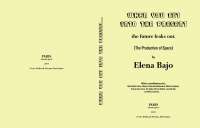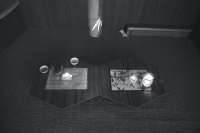THE UNINVITED GUEST? A Contrapunctual Proposal
Dear Elena,
Given the double or complementary nature and development of your entire project—as a book and as an exhibition—I’m assuming that the space you are referring to is understood not only as physical but also as text, discursive practice, and the norms and codes that organize the social. Ideally, my proposal should engage both the exhibition space and the space of the book on the same terms.
Conceived with no place of its own, my project would stand as a sort of symbiotic proposition within and in relation to all the rest of the projects, individually and collectively, that are to be included in your exhibition/book. Basically, my project is made up of a set of verses or sentences (in another version, these verses or sentences could be replaced by art works or artists’ interventions), the number of which would be determined by the number of projects involved in your exhibition/book. All the verses/sentences will address or refer to subjects, situations, or conditions related to physical, textual, or social space and such related concepts as place, location, environment, landscape, territory, architecture, home, etc. Each of these verses/sentences ideally will “take place” within the limits of the other projects, so as to encompass a fragmented “territory,” scattered among the projects of the exhibition and the book.
This irregularly spread and dispersed space is also a fluid and dynamic transaction that both denies its own conceptual cohesiveness and refuses its own physical “singularity.” It therefore prevents the possibility of a closed, totalized, homogeneous, or fixed space, becoming, instead, an unstable, shifting, hybridisable, situational, and perhaps obstinate or intractable negotiation. A refractory “space in migration” that might acquire a labyrinthic quality in its displaced and multiplicitous spatiality, it would feed from its own disintegration as much as from the multifarious projects and proposals that presumably will be its hosts—which, inevitably, would procure, and add, new paths and unpredictable directions to the maze, with their usual false leads, non-sequiturs and cul-de-sacs.
This project might be taken as an intruder, or even an outright alien, by the rest of the projects in which it aspires to engage and reside, for it threatens their integrity and perhaps their own coherence. Indeed, the instability of borders that this project relies on might intensify a sense of transgression and forcible entry into the space of the other projects. Crossing or transgressing into someone’s domain or project might, on the one hand, disturb the order, the structure, and the very being of that project; on the other hand, it might trigger a reaction that directs its efforts toward reinforcing the host project’s boundaries and identity as a singular and uncontested space.
Nevertheless, the intention on my project is neither invasive nor hegemonic. It is not a device to replace the host projects (a Trojan horse as if were), and it has no ambitions to become a protagonist. The presence of my project doesn’t even need to be obvious or prominent, easily identifiable or clearly located within the projects selected. It doesn’t require a sense of habitation, and it would not be longing for a fixed structure. It could be hidden behind a door, or it could be camouflaged as the title of a piece; it could be placed in the ceiling, or it could be accommodated among the pieces, works, or texts that make up any of the projects involved or selected in your scheme.
This space is not so much a space as it is a fiction of space. My project doesn’t necessarily have to be acknowledged by the host or maintain any kind of relationship with the host. We will only have physical contact, which might, or might not, lead to a mental, psychological, or semiotic engagement. Think about the anonymity of some newcomer in a bathhouse with whom you may or may not have sex without words or names being exchanged before, during, or after the contact. You can also think of an uninvited guest to a party, of a willing collaborator, and of an unknown person, to be adopted, perhaps indigent, yet always colourful.
In any of those cases, my project would produce a connection between disjoint experiences, for it would be an opportunity and a practice to rethink the common space, territory, or place that would be shared. But it would also disturb the supposedly stable, impermeable propositions that one might otherwise believe could exist for any one project, thoroughly independent from the others.
Octavio Zaya, summer 2009
THE UNINVITED GUEST? A Contrapunctual Proposal
Dear Elena,
Given the double or complementary nature and development of your entire project—as a book and as an exhibition—I’m assuming that the space you are referring to is understood not only as physical but also as text, discursive practice, and the norms and codes that organize the social. Ideally, my proposal should engage both the exhibition space and the space of the book on the same terms.
Conceived with no place of its own, my project would stand as a sort of symbiotic proposition within and in relation to all the rest of the projects, individually and collectively, that are to be included in your exhibition/book. Basically, my project is made up of a set of verses or sentences (in another version, these verses or sentences could be replaced by art works or artists’ interventions), the number of which would be determined by the number of projects involved in your exhibition/book. All the verses/sentences will address or refer to subjects, situations, or conditions related to physical, textual, or social space and such related concepts as place, location, environment, landscape, territory, architecture, home, etc. Each of these verses/sentences ideally will “take place” within the limits of the other projects, so as to encompass a fragmented “territory,” scattered among the projects of the exhibition and the book.
This irregularly spread and dispersed space is also a fluid and dynamic transaction that both denies its own conceptual cohesiveness and refuses its own physical “singularity.” It therefore prevents the possibility of a closed, totalized, homogeneous, or fixed space, becoming, instead, an unstable, shifting, hybridisable, situational, and perhaps obstinate or intractable negotiation. A refractory “space in migration” that might acquire a labyrinthic quality in its displaced and multiplicitous spatiality, it would feed from its own disintegration as much as from the multifarious projects and proposals that presumably will be its hosts—which, inevitably, would procure, and add, new paths and unpredictable directions to the maze, with their usual false leads, non-sequiturs and cul-de-sacs.
This project might be taken as an intruder, or even an outright alien, by the rest of the projects in which it aspires to engage and reside, for it threatens their integrity and perhaps their own coherence. Indeed, the instability of borders that this project relies on might intensify a sense of transgression and forcible entry into the space of the other projects. Crossing or transgressing into someone’s domain or project might, on the one hand, disturb the order, the structure, and the very being of that project; on the other hand, it might trigger a reaction that directs its efforts toward reinforcing the host project’s boundaries and identity as a singular and uncontested space.
Nevertheless, the intention on my project is neither invasive nor hegemonic. It is not a device to replace the host projects (a Trojan horse as if were), and it has no ambitions to become a protagonist. The presence of my project doesn’t even need to be obvious or prominent, easily identifiable or clearly located within the projects selected. It doesn’t require a sense of habitation, and it would not be longing for a fixed structure. It could be hidden behind a door, or it could be camouflaged as the title of a piece; it could be placed in the ceiling, or it could be accommodated among the pieces, works, or texts that make up any of the projects involved or selected in your scheme.
This space is not so much a space as it is a fiction of space. My project doesn’t necessarily have to be acknowledged by the host or maintain any kind of relationship with the host. We will only have physical contact, which might, or might not, lead to a mental, psychological, or semiotic engagement. Think about the anonymity of some newcomer in a bathhouse with whom you may or may not have sex without words or names being exchanged before, during, or after the contact. You can also think of an uninvited guest to a party, of a willing collaborator, and of an unknown person, to be adopted, perhaps indigent, yet always colourful.
In any of those cases, my project would produce a connection between disjoint experiences, for it would be an opportunity and a practice to rethink the common space, territory, or place that would be shared. But it would also disturb the supposedly stable, impermeable propositions that one might otherwise believe could exist for any one project, thoroughly independent from the others.
Octavio Zaya, summer 2009

